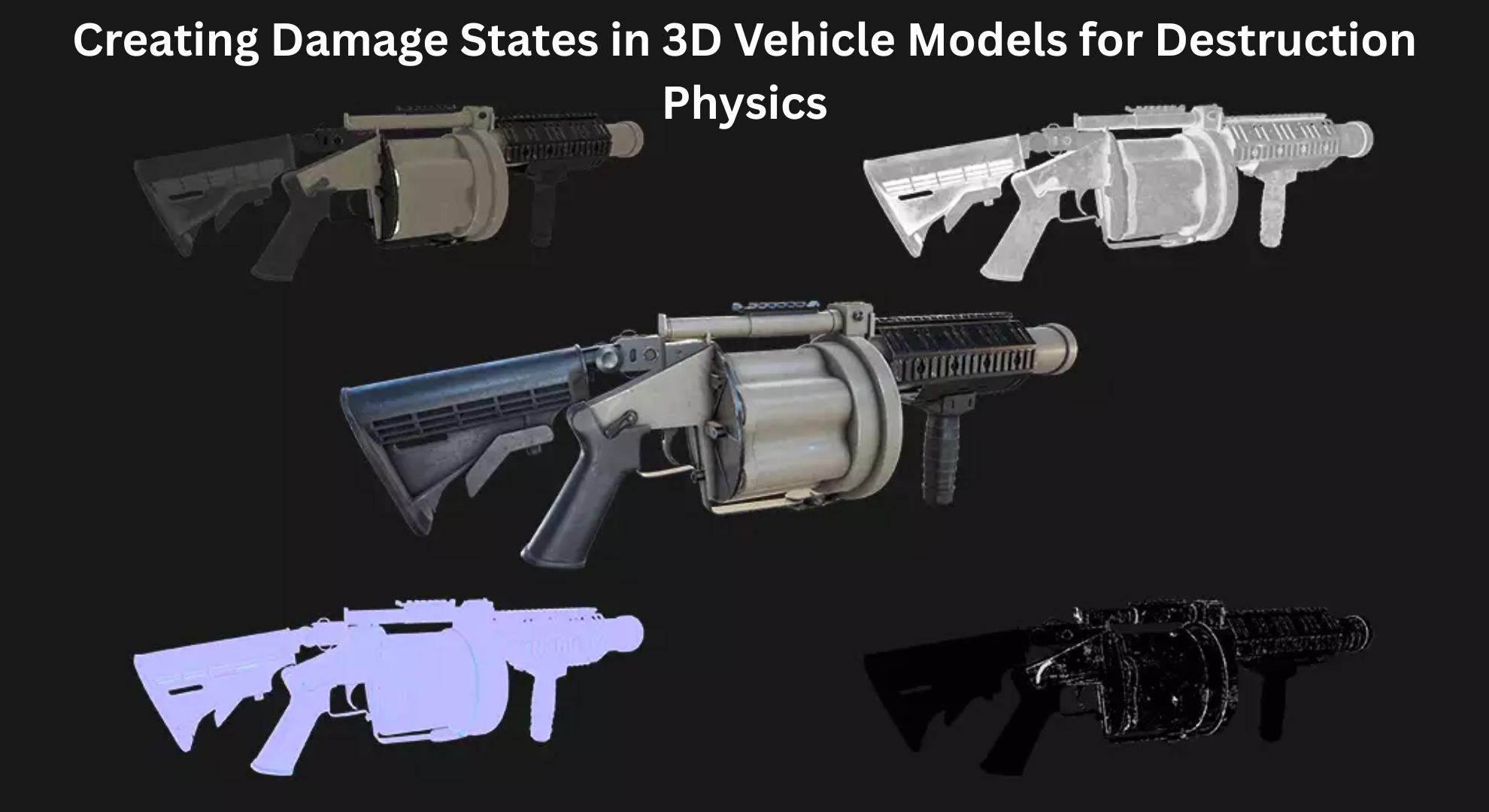Creating Damage States in 3D Vehicle Models for Destruction Physics

In modern 3D modeling games, realism isn’t just a luxury—it’s an expectation. From explosive crashes to minor fender-benders, players crave authentic vehicle behavior. One of the most critical techniques to achieve this immersion is the creation of damage states in vehicle models. When combined with destruction physics, this technique transforms a static car 3D model into a dynamic, responsive, and interactive experience. Whether you’re crafting 3D game assets for racing simulators or open-world shooters, modeling for damage plays a central role in enhancing realism.In this blog, we’ll explore the technical, artistic, and game-engine considerations involved in developing destructible 3D vehicle modeling assets, with an emphasis on 3D hard surface modeling, props 3D model.
Why Damage States Matter in 3D Vehicle Modeling
Games like Wreckfest, BeamNG.drive, and even Grand Theft Auto V showcase how responsive vehicle destruction deepens gameplay. A well-executed 3D game environments benefits from interactive vehicles that react believably to collisions, terrain impacts, and environmental hazards. This calls for thoughtful planning in how the car 3D model reacts visually and physically.In essence, damage states are pre-defined or procedural visual and physical transformations a vehicle undergoes during gameplay. To represent these accurately in games, developers rely on a mix of 3D game assets, physics calculations, and 3D environment modeling strategies.
Core Concepts of Damage-State Design
Creating damage states begins with understanding the underlying mechanics of destruction physics in a game engine (e.g., Unreal Engine, Unity). Let’s break down the key principles:
1. Multi-Level Mesh Design
A destructible 3D vehicle modeling pipeline starts with a detailed car 3D model broken into modular parts—hood, doors, bumpers, tires, windows, etc. Using hard surface modeling, artists sculpt these layers with precision to ensure a smooth transition between damage states.
2. Physics-Driven Interaction
For realism, the 3D game environments and vehicle must interact physically. This involves using soft-body or rigid-body physics systems to deform meshes based on collision forces. Deformation maps and physics constraints come into play here, ensuring parts behave naturally.
3. LOD and Performance Consideration
Vehicles with multiple damage states are heavier in polycount. Thus, LOD (Level of Detail) systems must be implemented to swap models at distances, critical for open-world or large-scale 3D modeling games.
Hard Surface Modeling: The Foundation of Damage
To create damage-capable vehicles, the artist begins with a pristine version of the car 3D model, then duplicates this base to sculpt progressive damage layers. These damage layers often involve:
- Vertex manipulation to simulate dents and creases.
- Edge breakup for torn metal effects.
- Broken part variations (e.g., cracked windshields or dislodged bumpers).
ZBrush, Blender, and 3ds Max are excellent tools for this, offering both high-poly sculpting and low-poly baking features crucial for game-ready 3D game assets.
Integrating Props into Destruction Sequences
Vehicle destruction rarely happens in isolation. Environmental elements such as trees, barriers, or roadside props contribute to the chaos. Integrating props 3D model assets like barrels, cones, or walls into the 3D game environment provides interactable obstacles that influence vehicle damage. Each props 3D model should have its own set of LODs, colliders, and physics properties to interact correctly with the vehicle. This interaction between vehicles and props ensures that the broader 3D environment modeling feels alive and reactive.
Texturing Damage States
Texturing plays a major role in conveying damage. Artists use:
- Tiling Materials to represent rusted or scorched areas efficiently.
Software like Substance Painter and Quixel Mixer is ideal for painting detailed textures that evolve with damage.In many 3D modeling games, texturing is tied to a material system that uses logic to swap materials based on health percentages or impact types.
Game Engine Implementation
Once the damaged and undamaged meshes, textures, and physics data are ready, implementation into the game engine begins.
Unity:
Artists and programmers can define damage zones and trigger events upon impact to switch mesh states or apply deformers.
Unreal Engine:
Artists can also use Blueprints or Niagara FX systems to trigger particle effects like sparks, smoke, and fire. Vehicle 3D game assets need to be rigged correctly with bones or constraints for movable parts (doors, hoods), enabling seamless part detachment during crashes.
Procedural vs. Pre-Modeled Damage
1. Pre-Modeled Damage
Artists manually sculpt different versions of the vehicle, and the game swaps these versions during play.
2. Procedural Damage
Real-time deformation driven by physics. The mesh responds dynamically to force, creating organic and unique damage patterns every time.High-end 3D modeling games often use a hybrid approach—pre-modeled base damage combined with procedural deformation for fine-tuned realism.
Optimization Tips for Destructible Vehicles
Creating destructible vehicles impacts performance, so here are some best practices:
- Use LOD transitions to reduce rendering costs at a distance.
- Group assets into logical damage zones to minimize physics calculations.
- Leverage instancing for reusable parts across multiple 3D game assets.
Optimization is crucial, especially in open-world or mobile games where system resources are limited.
Future Trends in Destructible Vehicle Modeling
As GPUs and game engines evolve, expect to see:
- Real-time soft-body simulation is becoming more accessible.
- AI-assisted damage generation using machine learning to predict realistic deformation.
- Cloud-based asset streaming, allows high-fidelity car 3D models to load dynamically.
- Cross-platform optimization, enabling complex destruction physics even in mobile or VR versions of 3D modeling games.
ConclusionCreating believable damage states in 3D vehicle modeling is more than just making things look broken—it’s about enhancing interaction, realism, and player immersion. By combining the strengths of 3D hard surface modeling, smart physics integration, and optimized 3D game assets, developers can breathe life into otherwise static vehicles. So the next time your virtual car slams into a tree, remember: behind every crunch and crumple lies careful planning, smart modeling, and the magic of destruction physics.
